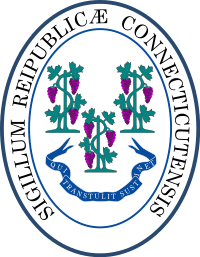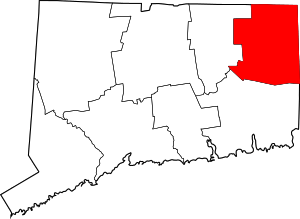Killingly, Connecticut
Killingly is a town in Windham County, Connecticut, United States. The population was 17,370 at the 2010 census. It consists of the borough of Danielson and the villages of Attawaugan, Ballouville, Dayville, East Killingly, Rogers, and South Killingly.
Killingly, Connecticut | |
|---|---|
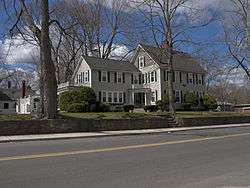 A house on Broad Street | |
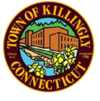 Seal | |
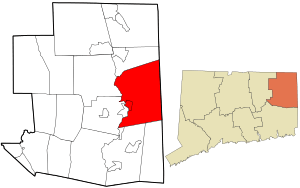 Location in Windham County and the state of Connecticut. | |
| Coordinates: 41°49′53″N 71°51′01″W | |
| Country | |
| State | |
| County | Windham |
| NECTA | Danielson |
| Region | Northeastern Connecticut |
| Incorporated | 1708 |
| Government | |
| • Type | Council-manager |
| • Town manager | Mary Calorio |
| • Council chairman | Jason W. Anderson (thru December 2021) |
| Area | |
| • Total | 50.0 sq mi (129.5 km2) |
| • Land | 48.5 sq mi (125.7 km2) |
| • Water | 1.5 sq mi (3.8 km2) |
| Elevation | 449 ft (137 m) |
| Population (2018)[1] | |
| • Total | 17,170 |
| • Density | 354/sq mi (133/km2) |
| Time zone | UTC-5 (Eastern) |
| • Summer (DST) | UTC-4 (Eastern) |
| ZIP code | 06239, 06241, 06243 |
| Area code(s) | 860 |
| FIPS code | 09-40500 |
| GNIS feature ID | 0213447 |
| Website | www |
| Historical population | |||
|---|---|---|---|
| Census | Pop. | %± | |
| 1820 | 2,803 | — | |
| 1840 | 3,685 | — | |
| 1850 | 4,543 | 23.3% | |
| 1860 | 4,926 | 8.4% | |
| 1870 | 5,712 | 16.0% | |
| 1880 | 6,921 | 21.2% | |
| 1890 | 7,027 | 1.5% | |
| 1900 | 6,835 | −2.7% | |
| 1910 | 6,564 | −4.0% | |
| 1920 | 8,178 | 24.6% | |
| 1930 | 8,852 | 8.2% | |
| 1940 | 9,547 | 7.9% | |
| 1950 | 10,015 | 4.9% | |
| 1960 | 11,298 | 12.8% | |
| 1970 | 13,573 | 20.1% | |
| 1980 | 14,519 | 7.0% | |
| 1990 | 15,889 | 9.4% | |
| 2000 | 16,472 | 3.7% | |
| 2010 | 17,370 | 5.5% | |
| Est. 2018 | 17,170 | [1] | −1.2% |
| US Decennial Census[2] | |||
History
In 1653, the second John Winthrop, son of Massachusetts Bay Colony's founding governor, obtained a grant of land formerly held by the Quinebaug Indian tribe and known as the Quinebaug (Long Pond) Country. The name "Quinebaug" comes from the southern New England Native American term, spelled variously Qunnubbâgge, Quinibauge, etc., meaning "long pond", from qunni-, "long", and -paug, "pond".[3]
The area in that grant that is now occupied by Killingly first saw settlement by European groups in 1700. It was first called "Aspinock", a word which may have come from the combination of the native term "aucks" or "ock" (the place of/where) and the name of the English settler, Lieutenant Aspinwall. When it was incorporated in May 1708, Colony Governor Saltonstall was asked to suggest a name. Saltonstall's ancestral manorial possessions lay in Killanslie and Pontefract, Yorkshire, hence he suggested “Kellingly” (the spelling was later altered).
During the 1830s, Killingly was the state's largest producer of cotton goods. By the 1930s it was an important producer of window curtains.[4]
Geography
According to the United States Census Bureau, the town has a total area of 50.0 square miles (129 km2), of which, 48.5 square miles (126 km2) of it is land and 1.5 square miles (3.9 km2) of it (2.94%) is water.
Principal communities
- Attawaugan
- Ballouville
- Chestnut Hill
- Danielson (borough)
- Dayville
- East Killingly
- Elmville
- Killingly Center
- Rogers
- South Killingly
On the National Register of Historic Places
- Broad Street – Davis Park Historic District — Roughly along Broad Street, from Dorrance Street to Winter Street (added 1998)
- Daniel's Village Archeological Site (added 1978)
- Danielson Main Street Historic District — Main Street from Water Street to Spring Street (added 1992), featuring Colonial Revival and Italianate architectural styles.
- Dayville Historic District — Main and Pleasant Streets (added 1988)
- Elliottville Lower Mill — Peep Toad Road (added 1982)
- Old Killingly High School — 185 Broad Street (added 1992)
- Temple Beth Israel (Danielson, Connecticut) — 39 Killingly Drive (added 2003)
Demographics
As of the 2010 United States Census,[5] there were 17,370 people, 6,749 households, and 4,528 families in the town. The population density was 358.1/square mile (137.9/km2). There were 7,592 housing units at an average density of 156.5/square mile (60.3/km2). The racial makeup of the town was 93.1% White, 1.5% African American, 0.4% Native American, 1.8% Asian, 0.7% from other races, and 2.4% from two or more races. Hispanic or Latino of any race were 3.0% of the population.
The borough of Danielson and the town of Killingly contain a small Laotian community. Both are on the nation's list of top 50 cities with the highest percentage of citizens claiming Laotian ancestry.
Of the 6,749 households: 29.2% had children under the age of 18 living with them, 47.8% were married couples living together, 13.2% had a female householder with no husband present, and 32.9% were non-families. 25.1% of all households were made up of individuals and 9.9% had someone living alone who was 65 years of age or older. The average household size was 2.52 and the average family size was 2.98.
The area population contained 22.4% under the age of 18, 8.2% from 18 to 24, 27.0% from 25 to 44, 28.5% from 45 to 64, and 13.9% who were 65 years of age or older. The median age was 40 years. For every 100 females, there were 97.4 males. For every 100 females age 18 and over, there were 94.7 males.
The median income for a household in the town was $55,598, and the median income for a family was $68,565. Males had a median income of $49,467 versus $35,429 for females. The per capita income for the town was $26,585. About 8.5% of families and 10.3% of the population were below the poverty line, including 12.7% of those under age 18 and 6.1% of those age 65 or over.
| Voter registration and party enrollment as of October 2019[6] | |||||
|---|---|---|---|---|---|
| Party | Active voters | Inactive voters | Total voters | Percentage | |
| Democratic | 2,616 | 146 | 2,762 | 24.18% | |
| Republican | 2,219 | 123 | 2,342 | 20.50% | |
| Unaffiliated | 5,680 | 404 | 6,084 | 53.26% | |
| Minor parties | 224 | 11 | 235 | 0.02% | |
| Total | 10,739 | 684 | 11,423 | 100% | |
Transportation
Danielson Airport is a state owned, public use airport located two nautical miles (4 km) northwest of the central business district of Danielson, a borough in Killingly.[7]
Bus service to the area is provided by the Northeastern Connecticut Transit District.
Notable people
- Francis Alexander, (1800–1881), born in Killingly, was a portrait painter[8]
- Harriet Pritchard Arnold (1858-1901), writer
- Manasseh Cutler (1742-1823) was a US representative, soldier, minister, botanist, doctor, and scientist. He was educated at both Yale and Harvard Universities. He lobbied Congress to pass the Northwest Ordinance of 1787, helped establish the Ohio Company, and worked to found Ohio University.
- Mae Flexer, Connecticut state senator
- William Torrey Harris (1835–1909), a philosopher who introduced reindeer to Alaska, educator (and later U.S. Commissioner of Education) who introduced the first permanent kindergarten, and lexicographer who introduced the "divided page" into dictionaries (the 1909 edition of Webster's New International Dictionary). He was born in North Killingly. He also founded the first philosophical journal in the country.
- Mary Dixon Kies (1752–1837), the first woman in the United States to receive a patent (in 1809, for a method of weaving straw with silk or thread). Kies was born and lived in South Killingly, an unincorporated village in the Town of Killingly.
- Samuel Knight, chief justice of the Vermont Supreme Court[9]
- Charles Tiffany (1812–1902) born in town, owner of Tiffany and Company (and father of the more famous Louis Comfort Tiffany, a designer)
- Ebenezer Young (1783–1851) was a United States Representative from Connecticut.
References
- "US Census Bureau Population Estimates". Retrieved 15 April 2020.
- "Census of Population and Housing". Census.gov. Retrieved 4 June 2015.
- Bright, William (2004). Native American placenames of the United States. University of Oklahoma Press. p. 405. ISBN 978-0-8061-3598-4. Retrieved 14 April 2011.
- "Local History". Killingly Historical and Genealogical Society. Retrieved 15 April 2020.
- "US Census website". US Census Bureau. Retrieved 31 January 2008.
- "Registration and Party Enrollment Statistics as of October 2019" (PDF). Connecticut Secretary of State. Retrieved 11 April 2019.
- FAA Airport Master Record for LZD (Form 5010 PDF). Federal Aviation Administration. Effective 31 May 2012.
- Who Was Who in America, Historical Volume, 1607-1896. Marquis Who's Who. 1967.
- Taft, Russell S. (January 1, 1894). "The Supreme Court of Vermont, Part II". The Green Bag. Boston, MA: Boston Book Company.
External links
| Wikimedia Commons has media related to Killingly, Connecticut. |

